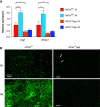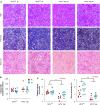Hepatocyte HIF-1 and Intermittent Hypoxia Independently Impact Liver Fibrosis in Murine Nonalcoholic Fatty Liver Disease
- PMID: 34003729
- PMCID: PMC8525205
- DOI: 10.1165/rcmb.2020-0492OC
Hepatocyte HIF-1 and Intermittent Hypoxia Independently Impact Liver Fibrosis in Murine Nonalcoholic Fatty Liver Disease
Abstract
Obstructive sleep apnea is associated with insulin resistance, lipid dysregulation, and hepatic steatosis and fibrosis in nonalcoholic fatty liver disease (NAFLD). We have previously shown that hepatocyte HIF-1 (hypoxia-inducible factor-1) mediates the development of liver fibrosis in a mouse model of NAFLD. We hypothesized that intermittent hypoxia (IH) modeling obstructive sleep apnea would worsen hepatic steatosis and fibrosis in murine NAFLD, via HIF-1. Mice with hepatocyte-specific deletion of Hif1a (Hif1a-/-hep) and wild-type (Hif1aF/F) controls were fed a high trans-fat diet to induce NAFLD with steatohepatitis. Half from each group were exposed to IH, and the other half were exposed to intermittent air. A glucose tolerance test was performed just prior to the end of the experiment. Mitochondrial efficiency was assessed in fresh liver tissue at the time of death. The hepatic malondialdehyde concentration and proinflammatory cytokine levels were assessed, and genes of collagen and fatty acid metabolism were examined. Hif1a-/-hep mice gained less weight than wild-type Hif1a mice (-2.3 g, P = 0.029). There was also a genotype-independent effect of IH on body weight, with less weight gain in mice exposed to IH (P = 0.003). Fasting glucose, homeostatic model assessment for insulin resistance, and glucose tolerance test results were all improved in Hif1a-/-hep mice. Liver collagen was increased in mice exposed to IH (P = 0.033) and was reduced in Hif1a-/-hep mice (P < 0.001), without any significant exposure/genotype interaction being demonstrated. Liver TNF-α and IL-1β were significantly increased in mice exposed to IH and were decreased in Hif1a-/-hep mice. We conclude that HIF-1 signaling worsens the metabolic profile and hastens NAFLD progression and that IH may worsen liver fibrosis. These effects are plausibly mediated by hepatic inflammatory stress.
Keywords: HIF-1; hepatic fibrosis; hyperglycemia; lipid metabolism; obstructive sleep apnea.
Figures






Comment in
-
Sleep Apnea, Hypoxia Inducible Factor, and Fatty Liver: More Questions Than Answers?Am J Respir Cell Mol Biol. 2021 Oct;65(4):337-338. doi: 10.1165/rcmb.2021-0204ED. Am J Respir Cell Mol Biol. 2021. PMID: 34101539 Free PMC article. No abstract available.
Similar articles
-
Hepatocyte Hypoxia Inducible Factor-1 Mediates the Development of Liver Fibrosis in a Mouse Model of Nonalcoholic Fatty Liver Disease.PLoS One. 2016 Dec 28;11(12):e0168572. doi: 10.1371/journal.pone.0168572. eCollection 2016. PLoS One. 2016. PMID: 28030556 Free PMC article.
-
Hypoxia inducible factor-1 promotes liver fibrosis in nonalcoholic fatty liver disease by activating PTEN/p65 signaling pathway.J Cell Biochem. 2019 Sep;120(9):14735-14744. doi: 10.1002/jcb.28734. Epub 2019 Apr 22. J Cell Biochem. 2019. PMID: 31009107
-
Activation of the Hypoxia Inducible Factor 1α Subunit Pathway in Steatotic Liver Contributes to Formation of Cholesterol Gallstones.Gastroenterology. 2017 May;152(6):1521-1535.e8. doi: 10.1053/j.gastro.2017.01.001. Epub 2017 Jan 11. Gastroenterology. 2017. PMID: 28088462
-
Galectin-3 and IL-33/ST2 axis roles and interplay in diet-induced steatohepatitis.World J Gastroenterol. 2016 Nov 28;22(44):9706-9717. doi: 10.3748/wjg.v22.i44.9706. World J Gastroenterol. 2016. PMID: 27956794 Free PMC article. Review.
-
Nonalcoholic fatty liver disease and obstructive sleep apnea.Metabolism. 2016 Aug;65(8):1124-35. doi: 10.1016/j.metabol.2016.05.004. Epub 2016 May 13. Metabolism. 2016. PMID: 27324067 Review.
Cited by
-
KAT's in the Cradle: p300/CBP and Regulation of HIF-1 and Blood Pressure during Intermittent Hypoxia.Am J Respir Cell Mol Biol. 2024 Feb;70(2):87-88. doi: 10.1165/rcmb.2023-0435ED. Am J Respir Cell Mol Biol. 2024. PMID: 38109691 Free PMC article. No abstract available.
-
Exposure of Primary Human Skin Fibroblasts to Carbon Dioxide-Containing Solution Significantly Reduces TGF-β-Induced Myofibroblast Differentiation In Vitro.Int J Mol Sci. 2024 Dec 3;25(23):13013. doi: 10.3390/ijms252313013. Int J Mol Sci. 2024. PMID: 39684728 Free PMC article.
-
The Influence of Sex Hormones in Liver Function and Disease.Cells. 2023 Jun 11;12(12):1604. doi: 10.3390/cells12121604. Cells. 2023. PMID: 37371074 Free PMC article. Review.
-
Duration of intermittent hypoxia impacts metabolic outcomes and severity of murine NAFLD.Front Sleep. 2023;2:1215944. doi: 10.3389/frsle.2023.1215944. Epub 2023 Aug 25. Front Sleep. 2023. PMID: 38077744 Free PMC article.
-
Intermittent Hypoxia Rewires the Liver Transcriptome and Fires up Fatty Acids Usage for Mitochondrial Respiration.Front Med (Lausanne). 2022 Feb 18;9:829979. doi: 10.3389/fmed.2022.829979. eCollection 2022. Front Med (Lausanne). 2022. PMID: 35252260 Free PMC article.
References
-
- Senaratna CV, Perret JL, Lodge CJ, Lowe AJ, Campbell BE, Matheson MC. et al. Prevalence of obstructive sleep apnea in the general population: a systematic review. Sleep Med Rev. 2017;34:70–81. - PubMed
Publication types
MeSH terms
Substances
Grants and funding
LinkOut - more resources
Full Text Sources
Other Literature Sources
Medical

